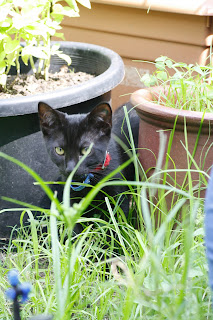Do they really all sleep on our bed all day, or did someone just forget to turn off the electric blanket?
It is a Sunday, this morning we attached the GPS logger to Jumble. Jumble is our oldest cat, he is 13. So far despite us gently encouraging him to go out and collect interesting GPS data, he has spent over an hour sitting on me, another hour sitting on Nigel helping him play computer games and a couple of hours sleeping in the sun in the back yard. Magellan is stalking an orange cat in the back yard and Corsair is asleep on the bed.
So we ask the question, are they more likely to stay home if we are home? We have a couple of housemates who provide ancedoctal evidence that says the cats are less likely to hang around the house when we are away on holiday.
So we pulled Corsair's GPS logging data from Saturday. Nigel was home all day Saturday. I was home Saturday afternoon. This data provides an interesting contrast to the three days of Corsair's travel data from last week, presented in the last post. Those three days of data were weekdays. Nigel came home in the evenings and I was out doing fieldwork so didn't come home at all for two of them.
The data shows that on Saturday morning Corsair got up, wandered over to House B at around 8am, probably for breakfast, then came home and spent pretty much the entire day at our house.I left the house at about 7am for an early morning bike ride. One of our housemates fed the cats and unlocked the cat flap as she left for work at about 7:30am. Nigel, with the house to himself enjoyed a leisurely sleep in and got out of bed around mid morning. Co-incidently, around the same time Corsair came home from her morning wanderings.
Ths map shows how many points we recorded within each property on Saturday. The vast number of points were recorded in our house with 265 points. The second most number of points were our immediate neighbours, with 116 and 58 points respectively. House B only recorded 23 points and House B's southern neighbour recorded 47 points. She also appears to have wandered through less properties on the weekend, 24 as opposed to 30+ and she spent more time on our side of the street.
We should also point out that the GPS logger cost all of $50, its a cheap device and there is every possibility that even with us filtering out the bad data, the good data is probably only accurate to within 10m and the OK data is probably only accurate to within 20m. So some of those points in our immediate neighbours properties are probably innaccurate and the cats are actually within our garden. We have to acknowledge the potential margin of error.
The map below illustrates the margin of error problem quite clearly. The data is time stamped and colour coded accordingly: 0 stands for midnight, 1 = 1am, 2 = 2am etc. Corsair was locked inside between 8pm and 7am and asleep on our bed for most of that. Yet the map shows points being recorded up to three houses away. Which shows that even with the data being filtered for horizontal dilution of precision the GPS is still fairly innacurate. That or Corsair has super escapey powers and there is a secret cat door that we are unaware of. This map does clearly show that Corsair wandered over to House B in the early morning and that once Nigel got out of bed, the focus of activity was our house. At 3pm the batteries on the GPS ran out :)
Now you can get GPS's with sub-centimetre accuracy. The GPS units we use in the field doing archaeology look something like this. A large ruggardised tablet sized device attached to a 2m aerial. Not really something you can attach to a cat. Also these units cost thousands of dollars.
So does any of this tell us if our cats really love us? Or does it just point out the limitations of GPS? Do our cats really appreciate our company? I notice that on days when I work from home, they are more likely to spend time inside. When I used to work from home full time, I certainly had company all day, even if only one cat at a time. I know Magellan has sat on my desk and watched me type most of this post. I know that when I came home from my bike ride yesterday afternoon I found Jumble and Nigel napping in the hammock.
I don't know what you think, but that looks like love to me.

























